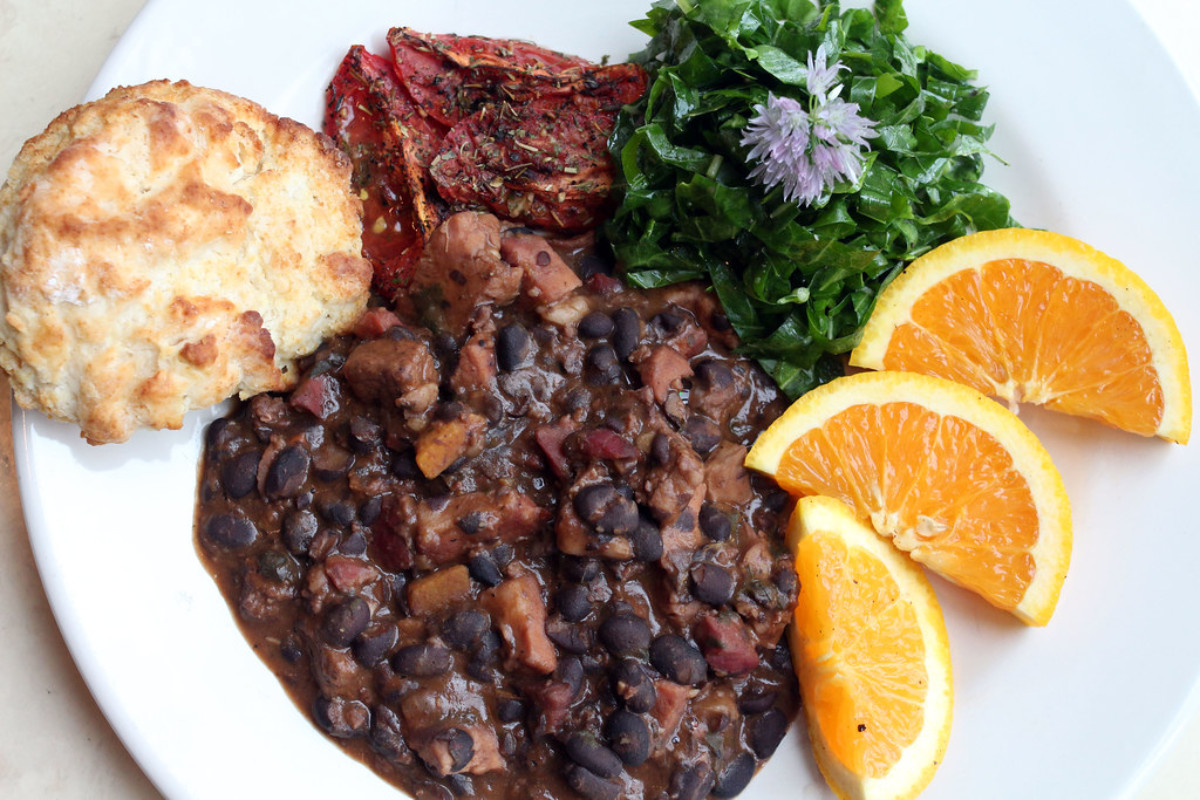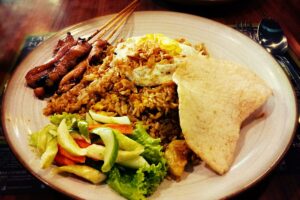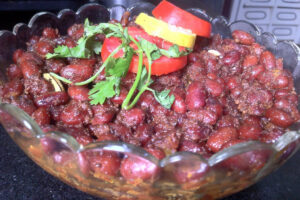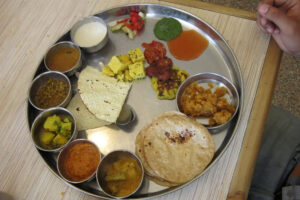Embark on a Culinary Journey Through Brazil’s Rich Food Culture
Brazil, a land of vibrant culture, stunning landscapes, and warm hospitality, is also a culinary paradise. The traditional food of Brazil is a reflection of its rich history, diverse cultural influences, and the abundance of fresh, local ingredients. In this comprehensive guide, we will take you on a culinary adventure through the most popular and authentic dishes that define Brazilian cuisine. From the hearty Feijoada to the exotic Pato no Tucupi, prepare to tantalize your taste buds and discover the heart and soul of Brazil’s food culture.
1. Feijoada: A National Treasure
Description:
Feijoada, often referred to as Brazil’s national dish, is a hearty and flavorful stew that is deeply rooted in the country’s culinary heritage. This iconic dish is made with black beans, various cuts of pork (such as smoked ribs, sausage, and bacon), and often includes beef as well. The ingredients are slow-cooked together, resulting in a rich and complex flavor profile that is both satisfying and comforting.
Feijoada is typically served with white rice, farofa (toasted cassava flour), orange slices, and collard greens. The combination of textures and flavors creates a culinary symphony that is truly unique to Brazil.
Recipe:
https://www.allrecipes.com/recipe/139208/feijoada-brazilian-black-bean-stew/
Key Ingredients:
- Black beans
- Smoked pork ribs
- Sausage (such as linguiça or paio)
- Bacon
- Beef (optional)
- Garlic
- Onions
- Bay leaves
- Orange slices
- Farofa (toasted cassava flour)
- Collard greens
Where to try it:
For an unforgettable Feijoada experience, head to Casa da Feijoada in Rio de Janeiro. This restaurant has been serving up this beloved dish for over 40 years and has earned a reputation for its exceptional quality and authenticity.
2. Moqueca: A Flavorful Seafood Stew
Moqueca, a vibrant seafood stew, is a true representation of Brazil’s coastal cuisine. This flavorful dish is believed to have originated in the state of Bahia, where it is prepared with fresh fish or seafood, coconut milk, dendê oil (palm oil), tomatoes, onions, peppers, and a medley of herbs and spices.
The combination of coconut milk and dendê oil gives Moqueca its signature creamy texture and vibrant color. The addition of tomatoes, onions, peppers, and spices creates a complex and flavorful broth that perfectly complements the delicate flavors of the fish or seafood. Moqueca is typically served in a clay pot, which helps to retain heat and enhance the flavors of the dish.
Recipe:
https://littleferrarokitchen.com/moqueca-brazilian-fish-stew/
Key Ingredients:
- Fresh fish or seafood (such as cod, shrimp, or prawns)
- Coconut milk
- Dendê oil (palm oil)
- Tomatoes
- Onions
- Peppers (such as bell peppers or chili peppers)
- Garlic
- Cilantro
- Lime juice
Where to try it:
For an authentic Moqueca experience, visit Restaurante Paraíso Tropical in Salvador, Bahia. This family-owned restaurant is known for its fresh seafood and traditional Bahian cuisine. Their Moqueca is a true masterpiece, showcasing the vibrant flavors and aromas of the region.
3. Vatapá: A Creamy Seafood Delight from Bahia
Vatapá, another culinary gem from Bahia, is a creamy and flavorful dish that is typically made with bread, shrimp, ground peanuts, coconut milk, and dendê oil. This rich and aromatic dish is often served as an accompaniment to Moqueca or as a main course on its own.
The combination of bread, shrimp, and peanuts creates a unique texture and flavor profile that is both satisfying and comforting. The addition of coconut milk and dendê oil adds richness and depth, while spices like ginger and chili peppers provide warmth and a subtle kick. Vatapá is a true celebration of Bahian cuisine and is a must-try for anyone visiting the region.
Recipe:
https://www.saveur.com/article/Recipes/Classic-Brazilian-Shrimp-Stew/
Key Ingredients:
- Bread
- Shrimp
- Ground peanuts
- Coconut milk
- Dendê oil (palm oil)
- Onions
- Tomatoes
- Garlic
- Ginger
- Chili peppers
Where to try it:
To savor the authentic flavors of Vatapá, head to Restaurante Yemanjá in Salvador, Bahia. This renowned restaurant is known for its traditional Bahian cuisine, and their Vatapá is a testament to the region’s culinary heritage.
4. Carne de Sol: Sun-Dried Beef with Northeastern Flair
Carne de Sol, or sun-dried beef, is a traditional dish that hails from the northeastern region of Brazil. This unique culinary creation involves salting and drying beef in the sun for several days, resulting in a concentrated flavor and a firm texture. The dried beef is then rehydrated and typically cooked with onions, garlic, tomatoes, and peppers.
Carne de Sol is often served with rice, beans, farofa, and a side of vinaigrette sauce. It’s a hearty and flavorful dish that is deeply rooted in the culinary traditions of northeastern Brazil.
Recipe:
https://travelfoodatlas.com/brazilian-carne-de-sol-recipe
Key Ingredients:
- Sun-dried beef
- Onions
- Garlic
- Tomatoes
- Peppers (such as bell peppers or chili peppers)
- Olive oil
- Salt
- Pepper
- Rice
- Beans
- Farofa
- Vinaigrette sauce
Where to try it:
To savor authentic Carne de Sol, head to Restaurante Mangai in João Pessoa, Paraíba. This restaurant is known for its traditional northeastern cuisine and offers a variety of dishes featuring Carne de Sol.
5. Baião de Dois: A Flavorful Rice and Bean Medley
Baião de Dois, a traditional dish from northeastern Brazil, is a harmonious blend of rice, beans, and a variety of other ingredients. This flavorful dish is typically made with long-grain rice, black-eyed peas or green beans, bacon, sausage, onions, garlic, and a medley of herbs and spices.
The combination of rice and beans creates a complete protein source, making Baião de Dois a nutritious and satisfying meal. The addition of bacon and sausage adds richness and depth of flavor, while the onions, garlic, and herbs provide a fragrant aroma and a vibrant taste.
Recipe:
https://www.saborbrasil.it/en/baiao-de-dois-riso-e-fagioli-cotti-insieme/
Key Ingredients:
- Long-grain rice
- Black-eyed peas or green beans
- Bacon
- Sausage (such as linguiça or paio)
- Onions
- Garlic
- Herbs (such as cilantro, parsley, or chives)
- Spices (such as cumin, coriander, or black pepper)
- Olive oil
- Salt
Where to try it:
To experience the authentic flavors of Baião de Dois, visit Restaurante Maria das Tranças in Fortaleza, Ceará. This traditional restaurant is known for its northeastern cuisine and offers a variety of dishes featuring Baião de Dois.
6. Tacacá: A Flavorful Amazonian Soup
Tacacá is a unique and refreshing soup that hails from the Amazon region of Brazil. This indigenous dish is made with tucupi (a yellow liquid extracted from wild manioc), jambu (a herb that creates a tingling sensation in the mouth), dried shrimp, and tapioca starch.
The combination of these ingredients creates a complex and flavorful soup that is both tangy and slightly spicy. The tingling sensation caused by the jambu is a unique culinary experience that is not to be missed.
Recipe:
https://blog.amigofoods.com/index.php/brazilian-foods/tacaca/
Key Ingredients:
- Tucupi (wild manioc extract)
- Jambu (herb)
- Dried shrimp
- Tapioca starch
- Salt
- Pepper
Where to try it:
To try authentic Tacacá, visit Mercado Ver-o-Peso in Belém, Pará. This bustling market is a hub of local flavors and offers a variety of food stalls serving Tacacá and other Amazonian delicacies.
7. Pato no Tucupi: A Duck Dish with Amazonian Roots
Pato no Tucupi is a traditional dish from the Amazon region that features duck cooked in tucupi (wild manioc extract). This unique dish is often served with jambu (the tingling herb) and rice.
The duck is typically marinated in tucupi and spices before being roasted or stewed. The tucupi imparts a tangy and slightly sour flavor to the duck, while the jambu adds a unique tingling sensation to the dish.
Recipe:
https://blog.amigofoods.com/index.php/brazilian-foods/pato-no-tucupi/
Key Ingredients:
- Duck
- Tucupi (wild manioc extract)
- Jambu (herb)
- Spices (such as garlic, onion, and bay leaves)
- Rice
Where to try it:
To try authentic Pato no Tucupi, visit Restaurante Remanso do Bosque in Belém, Pará. This restaurant specializes in Amazonian cuisine and offers a variety of dishes featuring tucupi and jambu.
8. Caruru: A Flavorful Dish with African Roots
Caruru is a traditional Afro-Brazilian dish that is popular in the state of Bahia. This flavorful stew is made with okra, dried shrimp, onions, tomatoes, peppers, palm oil, and a variety of spices.
The okra gives Caruru its signature thick and slimy texture, while the dried shrimp and palm oil add richness and depth of flavor. The dish is often served with rice and is a popular accompaniment to seafood dishes like Moqueca.
Recipe:
https://braziliankitchenabroad.com/caruru-recipe/
Key Ingredients:
- Okra
- Dried shrimp
- Onions
- Tomatoes
- Peppers
- Palm oil
- Spices (such as coriander, cumin, and chili pepper)
Where to try it:
To try authentic Caruru, visit Restaurante SENAC Casa do Comércio in Salvador, Bahia. This restaurant is part of a culinary school and offers a variety of traditional Bahian dishes prepared by skilled chefs.
9. Xinxim de Galinha: A Taste of Afro-Brazilian Heritage
Xinxim de Galinha, a flavorful chicken stew, is a testament to Brazil’s rich African heritage. This dish is believed to have originated in the state of Bahia and is a staple of Afro-Brazilian cuisine. Xinxim de Galinha is made with chicken, ground peanuts (or cashews), dried shrimp, coconut milk, dendê oil, and a blend of spices.
The combination of chicken, peanuts, and dried shrimp creates a rich and savory flavor profile, while the coconut milk and dendê oil add a creamy texture and a vibrant yellow hue. The spices, which often include ginger, garlic, and chili peppers, add warmth and depth to the dish.
Recipe:
https://www.agrimidia.com.br/receitas/xinxim-de-frango-uma-receita-saborosa-com-toque-baiano/
Key Ingredients:
- Chicken
- Ground peanuts or cashews
- Dried shrimp
- Coconut milk
- Dendê oil (palm oil)
- Onions
- Garlic
- Ginger
- Chili peppers
Where to try it:
To savor authentic Xinxim de Galinha, visit Restaurante Orixás Center in Salvador, Bahia. This restaurant is known for its traditional Afro-Brazilian cuisine and offers a variety of dishes that showcase the rich flavors and cultural heritage of Bahia.
10. Barreado: A Slow-Cooked Meat Stew from Paraná
Barreado, a traditional dish from the state of Paraná, is a slow-cooked meat stew that is known for its rich and intense flavors. This hearty dish is made with beef, bacon, onions, garlic, and a variety of spices. The ingredients are layered in a clay pot, sealed with a flour-and-water paste, and then cooked for hours over low heat.
The long cooking time allows the flavors to meld together and the meat to become incredibly tender. Barreado is typically served with rice, farofa, and a side of bananas. It’s a comforting and satisfying dish that is perfect for a cold day.
Recipe:
https://www.mindfood.com/recipe/barreado-brazilian-clay-pot-beef-stew/
Key Ingredients:
- Beef
- Bacon
- Onions
- Garlic
- Spices (such as cumin, bay leaves, and cloves)
- Flour
- Water
- Rice
- Farofa
- Bananas
Where to try it:
To try authentic Barreado, visit Restaurante Madalosso in Curitiba, Paraná. This family-owned restaurant is famous for its Barreado and has been serving it for over 50 years.
Conclusion: A Culinary Adventure Awaits
Brazil’s traditional food is a reflection of its rich cultural heritage and diverse culinary influences. From the hearty Feijoada to the exotic Pato no Tucupi, each dish offers a unique and unforgettable culinary experience. Whether you’re a seasoned foodie or a curious traveler, exploring the vibrant flavors of Brazilian cuisine is an adventure that you won’t soon forget. So, pack your bags, grab your appetite, and embark on a culinary journey through Brazil. With this comprehensive guide in hand, you’ll be well-equipped to navigate the country’s diverse food scene and discover the authentic dishes that make Brazilian cuisine so special. And remember, the best way to experience Brazil’s traditional food is to savor it with an open mind and a willingness to embrace the country’s rich culinary heritage.




